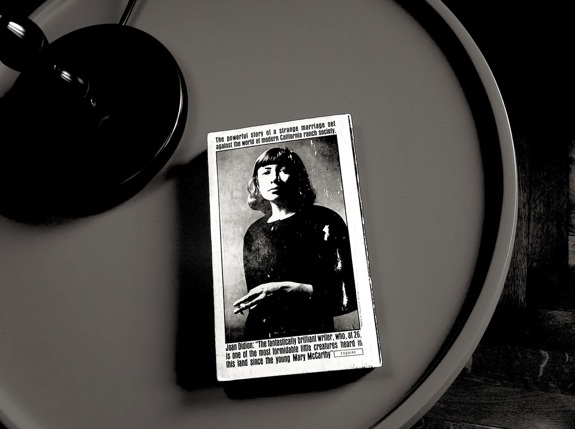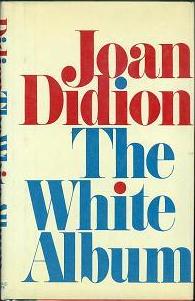Packing List Series, Part 1: Joan Didion
In 1979, “The White Album” gave smart women a straightforward guide to what to bring on a trip

Joan Didion’s work and lifestyle set the tone for a generation of women. Image: Incase
I was in that stage of packing where the suitcase was empty and the bed was piled haphazardly with clothes and the closet looks ransacked, when I suddenly and fondly recalled preparing for summer camp at Timber Tops in the Poconos. Every year we’d get that list from Timber Tops, a numerically descending inventory of summer: 15 pairs of socks, 15 pairs of underwear, 10 T-shirts, 5 pairs of shorts, 3 towels, 2 bathing suits, 1 pair of long pants, 1 long-sleeved shirt, 1 pair of sneakers, 1 pair of flip-flops, toothpaste, toothbrush, sunblock, bug spray. It was such a methodically satisfying process, gathering those items: Here was everything you needed for fun and freedom, and all you had to do was go down the list, cross the items off, fold them neatly into a duffel bag and head into the woods.
Today, no one gives you a list. What should the young professional woman in New York City pack for her frequent and varied travels? If only someone would itemize the few basic pieces I could throw in a bag at a moment’s notice that would accommodate any location or circumstance, garments that are easy and flexible but still feel stylistically appropriate (which, for me, discounts the ever-popular pants that unzip into shorts). Looking at my suitcase, I wanted a Timber Tops list for adulthood.
And then I remembered Joan Didion’s packing list from The White Album, which I quickly found on my bookshelf:
To Pack and Wear:
2 skirts
2 jerseys or leotards
1 pullover sweater
2 pair shoes
stockings
bra
nightgown, robe slippers
cigarettes
bourbon
bag with: shampoo, toothbrush and paste, Basis soap, razor, deodorant, aspirin, prescriptions, Tampax, face cream, powder, baby oilTo Carry:
mohair throw
typewriter
2 legal pads and pens
files
house keyThis is a list which was taped inside my closet door in Hollywood during those years when I was reporting more or less steadily. The list enabled me to pack, without thinking, for any piece I was likely to do. Notice the deliberate anonymity of costume: in a skirt, a leotard, and stockings, I could pass on either side of the culture. Notice the mohair throw for trunk-line flights (i.e. no blankets) and for the motel room in which the air conditioning could not be turned off. Notice the bourbon for the same motel room. Notice the typewriter for the airport, coming home: the idea was to turn in the Hertz car, check in, find an empty bench, and start typing the day’s notes.
—Joan Didion, The White Album
That list has stuck with me since I read The White Album and Didion became one of my favorite authors. I had the opportunity to meet Didion once, and in person she is a smaller-than-small apparition who speaks in a whisper, but you could still hear her robust, unceasing voice: Hers are words powerful enough to shift the way I saw the world. And this here, her packing list, was an itemized lens through which she saw the world. Her traveling uniform, her stuff—bra; nightgown; Tampax—could just as easily find their way into my own suitcase. I love how the simplicity of the list, what she travels with, stands in contrast to the complexity of the writing that comes from those travels.
And I’m not the only one! A January/February 2012 article in the Atlantic by Caitlin Flanagan captures the sentiment as well:
I once watched a hysterically sycophantic male academic ask Didion about her description of what she wore in Haight-Ashbury so that she could pass with both the straights and the freaks. “I’m not good with clothes,” he admitted, “so I don’t remember what it was.” Not remembering what Joan wore in the Haight (a skirt with a leotard and stockings) is like not remembering what Ahab was trying to kill in Moby-Dick.
Women who encountered Joan Didion when they were young received from her a way of being female and being writers that no one else could give them. She was our Hunter Thompson, and Slouching Towards Bethlehem was our Fear and Loathing in Las Vegas. He gave the boys twisted pig-fuckers and quarts of tequila; she gave us quiet days in Malibu and flowers in our hair. “We were somewhere around Barstow on the edge of the desert when the drugs began to take hold,” Thompson wrote. “All I ever did to that apartment was hang fifty yards of yellow theatrical silk across the bedroom windows, because I had some idea that the gold light would make me feel better,” Didion wrote.
Author and poet Meghan O’Rourke, mentioned in this Atlantic piece, also shared my enthusiasm about Didion’s packing list. I asked her why. She responded via e-mail:
There’s something about the precision of that list, and how the intimacy of the domestic detail broke the 4th wall between writer and reader, reporter and her text—making it all seem more real. I think it was also seeing myself reflected in it: the way I always worry over what to pack and wear when about to do something professional. One would never see a man write about his packing list—so there was a jolt of the familiar, of making a space for women who do this work. Also, frankly, it was the appeal of the uniform—going out into the world can be so vexing; Didion had found this kind of armor, a feminine armor, and I responded to that.
In Didion’s list, there was an intimacy in her plain documentation. Some telling detail in mundane disguise. And it made me curious about other packing lists in literature, art and so forth. I’ve dug up a few others that I’ll be sharing over the next couple of weeks. In the meantime, what would you include in your list?
/https://tf-cmsv2-smithsonianmag-media.s3.amazonaws.com/accounts/headshot/emily-spivack-240.jpg)

/https://tf-cmsv2-smithsonianmag-media.s3.amazonaws.com/accounts/headshot/emily-spivack-240.jpg)